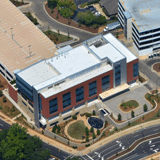Completed just more than a year ago, the new SECU Cancer Center at Mission Hospital in Asheville, North Carolina, was awarded LEED Gold certification in April 2012, making it the third Gold-certified cancer center in the United States and the largest certified facility of its kind in the state. Construction on the $38 million, 120,000-square-foot center was funded in part by a $5 million grant provided by the State Employees’ Credit Union for which the center was named.
Garrett Shreffler, a project manager for the Facility Project Management Department at Mission Health, says the planning for the cancer center began in late 2006. “At the time, the center was in conjunction with our master plan for the Biltmore Avenue Campus,” he says. “After numerous site studies and programming efforts, we started . . . construction in April 2010.”

The large outdoor waterfall at the cancer center serves as a centerpiece to the garden area and uses recycled storm water.
LEED was relatively young in 2006, but Shreffler says three things led to the center seeking certification: First, because patients in the SECU Cancer Center are often afflicted with compromised immune systems resulting from the treatments of their illnesses, a clean and efficient air and ventilation system is vital for mitigating the risks of airborne illnesses. Second, the cost savings fostered by the systems and standards enforced by the LEED certification checklist allow for realized savings and the possibility for dollars to be allocated to other important services and initiatives. Lastly, the hospital is a central and long-standing institutional resource for the community, so a LEED certification both reflects the interests and needs of the community and establishes a precedent for other health-care facilities throughout the state. One reason might have been enough, but with three, LEED status became a no-brainer.
“The community has a very active interest in environmentally friendly, energy-efficient, and sustainable design,” Shreffler says, “so we designed and built the facility with the intention of being good stewards of our responsibility to the community.”
TRO Jung | Brannen designed the building to be 25 percent more energy efficient than comparable buildings, and plumbing systems in the building use 40 percent less water than standard cancer treatment facilities, saving 125,000 gallons annually. During the building process, helmed by Alabama’s Brasfield & Gorrie, more than 90 percent of on-site construction debris was recycled, which diverted 6,000 tons of waste from local landfills.
The landscape surrounding the five-story center suits adaptive and drought-tolerant vegetation because it is built around a high-efficiency irrigation system that is supplied from storm water retained on-site in a 21,000-gallon subterranean tank. The reservoir also supplies an exterior water feature: a waterfall implemented as a background feature for soothing patient anxieties in the garden area.
The roof, a portion of which includes a vegetative roof system, is coated with a reflective material to prevent excessive in-building solar heat gain. The exterior nighttime lighting was designed to eliminate unnecessary upward radiance and reduce light pollution. The floor plan for the building maximizes daylighting possibilities and reduces reliance on electric light fixtures, many of which are moderated by occupancy sensors, and an automated lighting system controls light usage throughout the center after hours.
The trustees of Mission Foundation raised $15 million for the construction of the center, accounting for nearly 40 percent of the total project cost. The foundation initiated its campaign when construction on the center began in 2010 and was immediately jump-started by the SECU Foundation, whose $5 million contribution earned them the naming rights for the center.
“The campaign is one of the largest, most successful campaigns in the region during the past decade,” says John Locke, Mission Foundation campaign director, in a statement. “It shows that when our region feels passionately about ‘taking care of its own’ they step up and give generously.”

